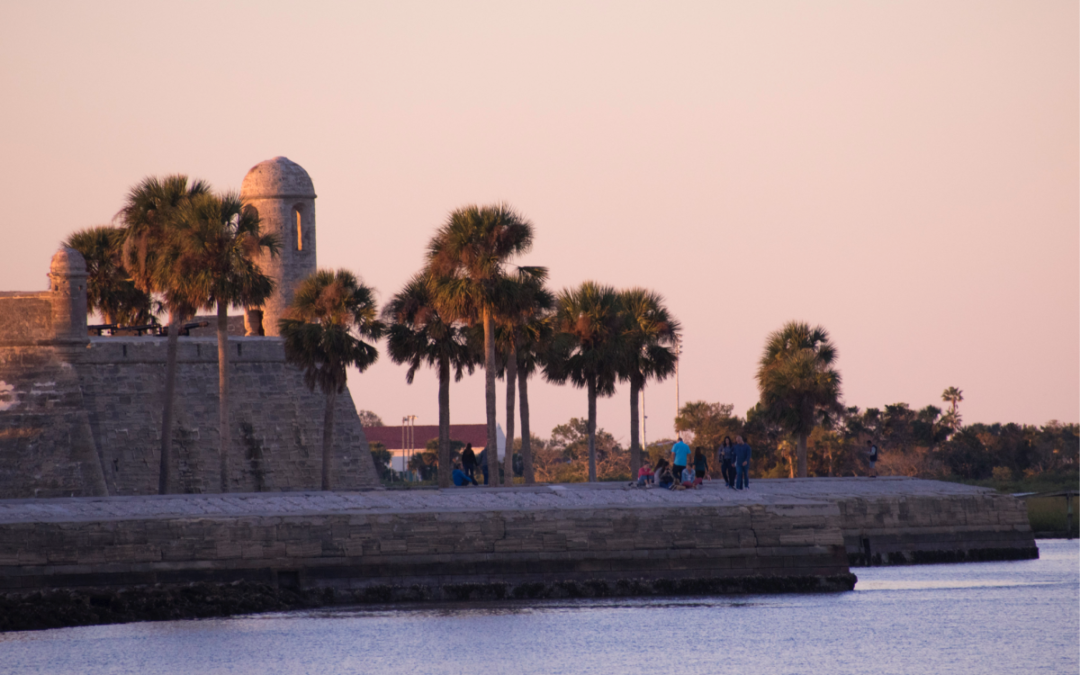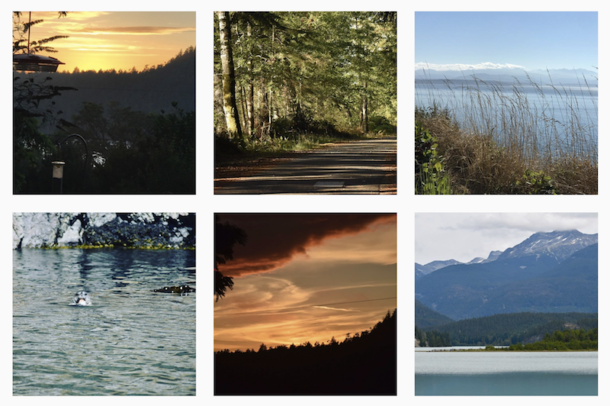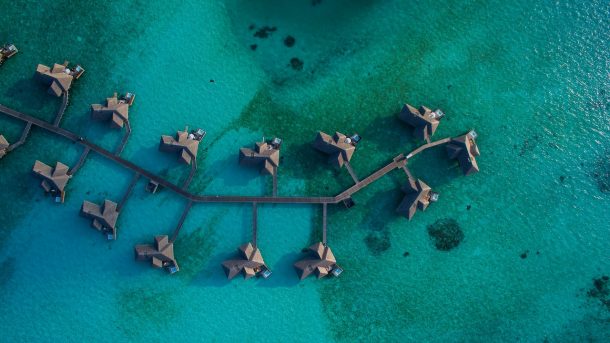St. Augustine is my kind of town, at least in October, with tourist traffic relatively light and the weather relatively cool.
It’s a combination of money, elegance and grace. Set, of course, against a history of Spanish conquest. With beautiful beaches and fresh ocean air.
St. Augustine History
St Augustine is the oldest continuously occupied European established settlement in the U.S. That’s not to say it hasn’t been the subject of attacks, sieges, been burned to the ground, traded between the British and the Spanish, and then the Americans. Throw in a Civil War and an oil tycoon who decided to create a winter haven for the wealthy, and you have a town with a story.
St. Augustine was founded in 1565 by Pedro Menendez de Aviles who was named Florida’s first governor. The site would remain the capital of Spanish Florida for 200 years, despite being burned to the ground by Sir Francis Drake in 1586. In 1819 the Adams -Treaty Spain ceded the territory to the US.
This Florida city was a strategic part of navigating the New World and of protecting Spanish galleons in their gold trading routes between the New World and Old. As English settled territories further north, conflict was inevitable.
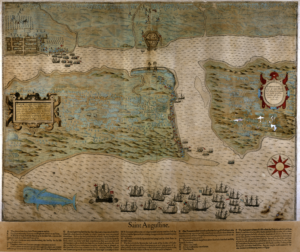
St. Augustine 1589
The history of St. Augustine is a fascinating read. The current masonry Fort Castillo de San Marcos was completed in 1695, partly as a result of the English presence in the area which threatened Spanish interests. The fort withstood the English onslaught of 1702, but the town was burned to the ground by the British. In 1740 the British had another failed attempt to take the port.
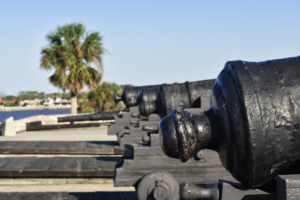
Artillery lined up at the Castillo de San Marcos in St. Augustine
In 1763 the Treaty of Paris ceded Florida To Great Britain in time for it to become a loyalist haven during the Revolutionary war. The second Treaty of Paris ceded Florida back to Spain. This possession would last from 1784-1821 when Florida became part of the US.
Got all that? Add in some Indian wars, the Civil War and whatnot, and this little town has had a stormy history of warfare and upheaval that goes back centuries.
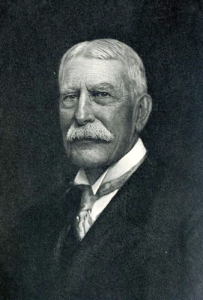
Portrait of Henry Flager Source: Wikipedia
But all that would change when Henry Flagler entered the picture. Henry, co-founder of Standard Oil visited the area in 1883. He combined several small railways into the Florida East Coast Railway, built a bridge, and Florida was open for development.
Flagler’s vision was to create a wealthy enclave for winter escape. To that end he built two hotels, the Alcazar and the Ponce de Leon. For several years, Flagler put St. Augustine on the society map, but as the rail system extended south, so did the preferences of his clientele who headed towards warmer winter weather.
Flagler’s influence is felt everywhere in this coastal town. The town benefited enormously from his vision. Flagler College occupies the original Ponce de Leon Hotel and the Alcazar continues on.
The town itself is compact and very walkable. There is an Old Town Trolley that offers a good way to get the lay of the land. Should you do this, be sure to cruise by the St. Augustine Distillery at lunchtime. The restaurant is excellent and downstairs is a tour of the premises.
A helpful hint: the trolley usually stops off the main road. The stops are poorly marked on the map and often hard to find. Think off road when looking for the hop on, hop off stops.
11 Things To Do in St. Augustine:
Castillo de San Marcos
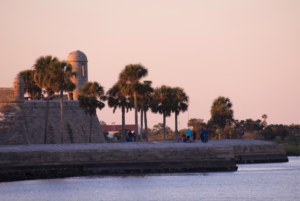
Castillo de San Marcos overlooking the harbor at St. Augustine
This fort was originally built in the 1600’s by the Spanish, both to protect the outbound Spanish galleons laden with gold and as a land based strong point to thwart English movement to the south. Fort hours are listed here.
While you are at the fort. take the time to go across the street to the visitors center. There is an excellent exhibit of St. Augustine history and a plaque marking the start of the Spanish trek westward to the other forts and missions in the southwest.
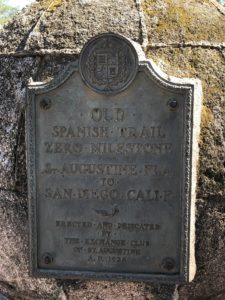
St. Augustine was the most eastward of the Spanish missions built to solidify Spanish control of territory and people, and to provide protection for the galleons carrying gold and silver back to Europe.
The Bridge of Lions

Looking westward across The Bridge of Lions in St. Augustine
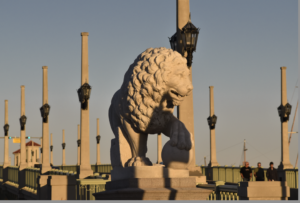
The Carrera marble lions guard the bridge entrance.
The Bridge is named for the pair of marble Medici lions that guard the St. Augustine side of he bridge. These lions are copies of the ones in the Loggia Dei Lanzi in Florence.
The original bridge over the Intercoastal Waterway and Matanzas Bay to Anastasia Island was a simple wooden structure. It would be replaced by the efforts of Henry Rodenbaugh, an executive working for Henry Flagler’s Florida East coast Railway. The construction of the new bridge coincided with the 1920’s Florida land boom and cost ten times as much as other nearby bridges. The bridge would again be renovated starting in 2006 and reopening in 2010.
St. Augustine Distillery Co.
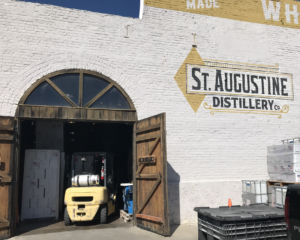
St. Augustine Distillery warehouse operations in the old Ice House
This company is housed in the historic 1907 FP&L Ice Plant which made commercial block ice over 100 years ago. The building is on the National Historic Register and part of Lincolnville.
Tours are free and start every half hour. Like distilleries in other areas, this is part of a national movement of distilling local premium small batch spirits. The upstairs restaurant not only showcases the distilled liquors from below, but has great ambiance and food.
Lincolnville
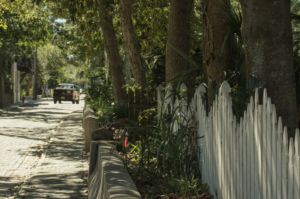
This section of St. Augustine, FL originally provided a neighborhood for African American workers. Today it’s a beautiful shaded neighborhood with wonderful architecture, within an easy walk of downtown St. Augustine.
Originally known as Little Africa, Lincolnville was established after the American Civil War in 1866. The area evolved as St. Augustine did. During Henry Flagler’s reign, the eastern boundary of Lincolnville was expanded to the Ponce de Leon Barracks at 172-180 Cordova Street, a significant historic building. During the late 19th and 20th centuries, workers from Flagler’s hotels lived here.
Today Lincolnville retains some of its original architecture. Some is run down; some is renovated. One local complained that it may be on the verge of being gentrified. I have no comment on that trend, but this area of town is a place one could live, in easy walking distance of all the charms of St. Augustine.
St. Augustine Lighthouse
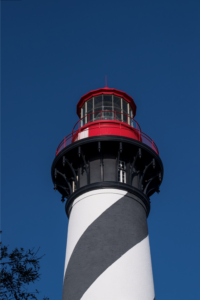
The restored lighthouse on Anastasia Island.
The St. Augustine Lighthouse was built in 1874 on the site of an earlier tower built by the Spanish in the 16th century, located at the north end of Anastasia Island. The lighthouse owes its restoration to the Junior Service League of St. Augustine (JSL), which along with the Coast Guard were instrumental in gaining control of the restoration project. A 99 year lease was signed with the county for the keeper’s house and surrounding grounds, and a massive renovation project were started. Inclusion on the National Register is thanks in part to the considerable efforts of local preservationist and author Karen Harvey.
The Hotel Ponce de Leon (Flagler College)
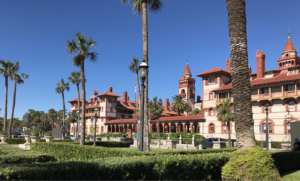
Flagler College in St. Augustine is another legacy of Henry Flagler
This incredible baroque/moorish building was originally built by Henry Flagler as a resort –The Hotel Ponce de Leon–for his well to do clientele. It is said that a season’s stay cost the modern day equivalent of $100,000. Today it’s a four year liberal arts college offering 29 majors and a student led tour that’s rather interesting. It’s worth an hour of your time to get some insight into Henry Flagler’s flagship property.

The ceiling in the entry rotunda at Flagler College, originally built as the Hotel Ponce de Leon by Henry Flagler
The interior includes elaborate decor that welcome students and visitors alike. The dining room has over 70 Tiffany windows and there is actually a separate ladies waiting room just down the hallway. It is said that the women waited here while bills were settled, with the intent of keeping them ignorant of the financial side of things. Hmmmm….
Wander the Town

St. Augustine, FL is full of beautiful cobblestone streets perfect for wandering and exploring.
This is a small town and oh so walkable! Wander the streets. Try the restaurants. Rent a bicycle. Enjoy the off season ambiance of this beautiful and historic Florida town!
Cathedral Basilica of St. Augustine
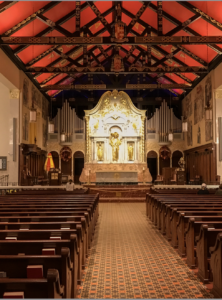
The restored interior of this church is breathtaking. Pictures don’t do it justice, but a visit would!
This is an 18th century cathedral that has been restored in beautiful detail. It was originally established in 1565 and re-built in the 18th century. It is the oldest church in Florida, with a combination of Spanish and neo-classical architecture.
Take the time to stop in. It’s an integral part of St. Augustine history. The church is located at Cathedral Street between Charlotte and St. George Streets. It was constructed over five years (1793–1797), and was designated a U.S.National Historic Landmarkon April 15, 1970.
St. Augustine Cemeteries
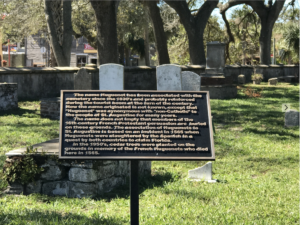
Religious tensions showed in many ways. Here a Huguenot cemetery speaks to past social differences and tensions.
Visiting a cemetery may sound boring or even odd, but actually burial grounds offer a unique look at the people and culture of an area, at a point in time. In St. Augustine, for example, the Huegenots and the Catholics have separate burial areas, pointing to the role of religion in the social strata and evolution of this early city.
Dining and Snacking in St. Augustine
 So many restaurants from which to choose! Mayan, New Orleanian and simple costal food mingle together to create a very nice dining experience for nearly everyone.
So many restaurants from which to choose! Mayan, New Orleanian and simple costal food mingle together to create a very nice dining experience for nearly everyone.
 I’m not going to single out any one restaurant, but there is one foodie place that you must stop.
I’m not going to single out any one restaurant, but there is one foodie place that you must stop.
Ready?
Don’t laugh too hard!
Ms.-I-don’t-eat-sugar-on-my-anticancer-diet (yours truly) highly recommends (drum roll please!): The Hyppo for over 450 amazing popsicle flavors like Bourbon Peach, Sangria Plum and more! Sweetening is via fresh cane juice (i.e., sugar! Which is decidedly NOT on an anti-cancer diet!)
Stop in and treat yourself. The amazing flavors are available for shipping as well.
Lodging

Nine houses in this enclave create a luxury setting, complete with gardens, a pool and a restored garage that has become an evening cocktail hangout.
Perhaps one way to convey the utter charm of this coastal enclave is to share the place I stayed, The Collector. On the one hand I want to rave about this amazing find. On the other hand, I’m afraid it will become so popular that I’ll never get in again!
The recently renovated Collector is just that: the legacy of Mr. Kenneth Dow’s collections. It started with his collections of mostly European art and then Mr. Dow moved on to collecting houses. Each house in the enclave has its own story and history that is interwoven with that of the town. The entire property has been fully restored and is open for business as a luxury enclave. And it is simply fantastic.
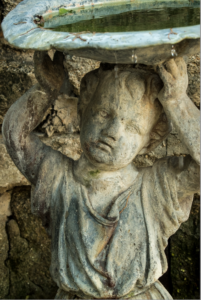
One of the many art pieces that are on the grounds of The Collector.
This unique inn is a collection of nine historic houses spanning from 1790-1910. A tour is available most mornings, and it’s worth doing, both to see all the houses and understand a bit of the story behind each. Given the age of many of the houses, The Collector is a microcosm of the history of St. Augustine itself, told through the stories of the people and situations that evolved around each house.
The houses on this property include:

Daily tours of The Collector are available. Take one! The history behind this enclave is astonishing.
Star General Store 1899-1904
Canova/De Medici House 1840-1898
Caprenter’s House 1901
Dow House 1839
Prince Murat House 1790 (This house tracks back to Napoleon’s nephew!)
William Dean Howells House 1907
Rose House 1909
Spear House 1899-1903
Worcester House 1906
Each house has been lovingly restored and furnished with art and furniture from Mr. Dow’s collections. The property is stunning and includes The Well House, a former garage, now an evening watering hole for property’s guests. Outside are fire pits with Adirondack chairs where one can meet and share a few stories with fellow travelers.
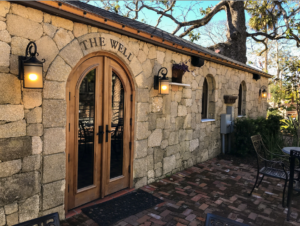
This restored garage doubles as a bar on the property. Evenings, with the fire pits lit, guests can stop in for a glass of wine or a cocktail, before or after dinner.
This stay in St. Augstine was far too brief. I had the feeling that this was a place I could settle into for a bit and just enjoy the people, the town and the weather before the onslaught of the snowbirds. But the itinerary had several fixed dates, so onwards, and south it was.
Visit the St. Augustine photo gallery here!
More On Florida:
Weekend in Ft. Lauderdale
Little Havana, Miami
The Sanderlings of Florida
Cats, Roosters and Hemingway in Key West
Key West
St. Augustine
Traveling the Timeline of Now
A Cuban Inspired Culinary Tour in Miami’s Little Havana
Like this post? Share it!
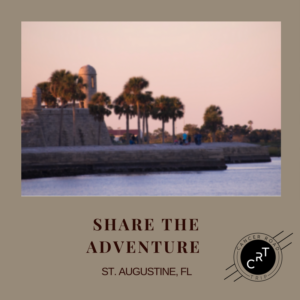
If you’re interested in learning more about photography (or cooking or film or any number of topics) check out Masterclass for on-line excellence:
What is #CancerRoadTrip and how did it come to be? Read this post to get the backstory!
Follow me on Twitter, Pinterest, Instagram, and at Anti-Cancer Club. Connect with me! I may need a place or two to stay along the way!
